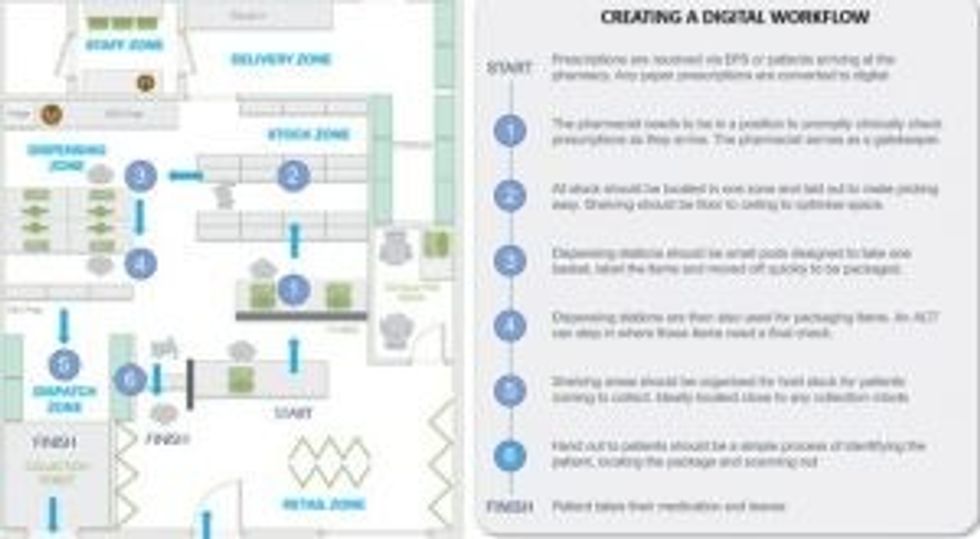Tariq Muhammad considers how layouts are a key to modernisation and why pharmacies need a digital and physical harmony…
An increasingly common question I get from existing and prospective customers is, “I am fitting out my pharmacy, what layout would you recommend with Titan”? The question is then promptly followed up with some drawings sent to my inbox.
If I am lucky, I will get a proposed layout done by a professional shop fitting company, but on other occasions I will have the pleasure of receiving an amusing hand drawn sketch of a building unit with rough dimensions and asked if I can “help out with some ideas”. I reply with a face palm emoji.
If time allows, I oblige, although I do wonder how many other industries there are where you would ask the software supplier to organise the layout of your premises. However, the question does highlight an important issue and the need to think beyond technology if we are to modernise and transform community pharmacy.
Walk into any pharmacy and it pretty much looks the same as any other. Sure, some look more visually more modern than others, but the layout is pretty much the same. The typical design of the dispensary usually maximises surface area as much as possible.
There is typically a central island surrounded by benches. Above and below every bench, there is shelving and cupboards to cram in as much stock as possible. Shop-fitting companies can certainly help you part with some hefty cash sums to create an aesthetically pleasing look.
However, an ‘award winning’ look does not necessarily equate to operational efficiency.
The large surface areas serve as nothing more than a holding pen for endless piles of baskets and clutter. The more surface area, the more baskets you will have. Staff reach over each other as they try to access the stock above the person who is working at the bench. Once stock is picked, it is mixed in with the existing mountain of baskets.
The concept of workflow does not exist in this world. When the patient eventually comes in to collect their prescription, it is no wonder why nothing can be found.
If it’s showing as labelled on the PMR and it’s not on the completed shelves, then good luck trying to find it in the sea of baskets on the benches.
If this sounds familiar then be reassured you are not alone. The current workflow (or lack of) in pharmacy is mainly down to the processes built around traditional PMR systems. Historically, their function has been limited to receiving prescriptions, printing paper copies (if EPS) and issuing all the labels.
After this point the PMR serves no function, leaving pharmacy staff to make up their own manual processes to get prescription picked, labelled, checked and packaged. It is therefore little surprise that even the most expensively fitted out pharmacies can end up looking chaotic.
When designing Titan PMR, I had a particular goal in mind. The goal was not to just make another PMR but rather create a digital workflow which delivered operational efficiency and reduced time spent in dispensing. In order to do this, we need to think about the operation, service, workflow as a whole and create an environment where the digital realm is in harmony with the physical realm.
Titan’s core USP is that it retains control of every step of the dispensing process. It simply does not allow you to print off everything and go it alone with your manual process. In fact if you try this, it will make things more cumbersome. Instead, Titan takes the prescription on a journey of six key steps including, (1) clinical checking, (2) picking, (3) labelling, (4) packaging, (5) shelving and (6) handing out.

Figure 1 shows a suggested layout of a pharmacy which has been optimised for digital workflow. It is worth noting each stage of the digital dispensing workflow is matched with a distinct area in the pharmacy.
Each area also serves a single purpose only. For example, all stock is located in aisles where stock can be picked, supermarket style.
Dispensing benches are replaced with smaller pods that are designed only for labelling and packaging, supermarket checkout style. If something gets stuck, it gets put in a designated area and never left on the bench. The aim is to create a production line where there is simply no place for baskets to hang around. Once this concept is flowing, if anyone wants to know where anything is, simply check Titan and the prescription can be located instantly.
With the rapid evolution of technology in pharmacy, it is natural to think that there is a software solution for every problem in pharmacy. But in the same way as we advise our patients to look beyond medication to improve their health, we need to look beyond technology if we want to solve all the issues in pharmacy.
Consideration of the physical space and operational workflow are key ingredients in any solution. If this can be optimised alongside a digital PMR workflow, then we can deliver a truly healthy operation which is fit for the future.
(Tariq Muhammad is CEO at Invatech Health.)











